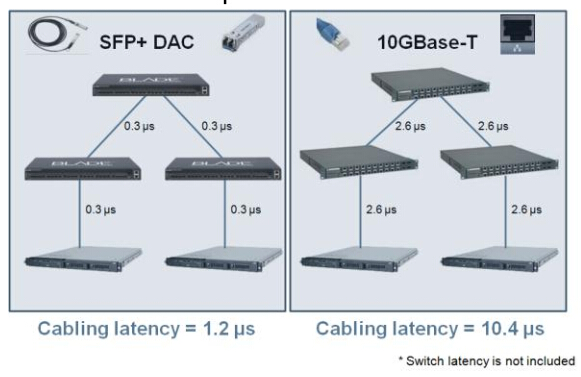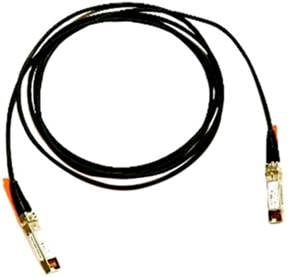Fiber Optics Solutions
ponedjeljak, 23.03.2015.
10GBASE-T vs SFP+ DAC
Eight years ago, the networking industry was gearing up for massive uptake of copper-based 10 Gigabit Ethernet (GbE) using 10GBase-T. As a result, we are seeing the expansion of higher speed Ethernet solutions, specifically 10 and 40 gigabit Ethernet.
In particular to 10 gigabit Ethernet (10GbE), which is booming with new applications accentuating the differences between Ethernet adapter designs, copper is back on the 10GbE menu. Only now the copper option is in a newer format called SFP+ Direct Attach Cable, which uses twin-axial copper cable and plugs into the SFP+ receptacles also used for fibre optics.
These questions were asked by network switch users. Maybe you have the same question. What's the main difference when you choose the 10GBASE-T or SFP+ DAC?
10GBase - T
10GBase - T – IEEE standard 802.3an - 2006 for operation at 10 gigabits per second over Cat 5/6/7 twisted pair cable at distances up to 100 meter. 10GBase-T works at 100 meters for Cat6A or Cat7 cable, and up to 50 meters for Cat6, Cat 5E, or even Cat 5 cable.
In the early days of Ethernet there were several PHY standards, including various forms of coaxial cable, but Ethernet only gained widespread adoption once it was run on twisted pair cable, and as point - to - point rather than an unstructured loop. It became practical to run an Ethernet cable to each desktop alongside the phone cable, and make all the connections in a wire closet. The connector used for twisted pair was the RJ45 connector.
Many IT managers are now evaluating the newly refreshed 10GBase-T technology, as the perception is that 10GBase-T is cheaper and easier to deploy than the alternative SFP+ technologies.
SFP+ DAC
Instead of installing
an optical transceiver at each end plus a length
of fiber optic cable
, a cable was invented with
each end physically resembling an SFP+
transceiver, but with none of the expensive
electronic components. A small component is
required to identify cable type to the SFP+ host,
but its cost is negligible. This innovation, call
ed
either Direct Attach Cable (DAC cable) or twinax, is a
low cost solution for shorter distances, while
keeping the high
-
density equivalent to RJ45
connectors.
The following table compares these two technologies:

Two microseconds may not seem high at first; however, if we imagine a TOR infrastructure where traffic is passing 4 hops to reach the destination, as much as 10.4usec delay is introduced when using 10GBase-T. This is a significant performance penalty compared to using 1.2usec introduced by the SFP+ DAC technology.

The 10GBase-T delay becomes the same order of magnitude as Solid State Disk latency, and therefore dramatically delays data delivery by nearly 50 percent. High latencies in the data center infrastructure results in delays in CPU and application works, therefore limiting data center efficiency and increasing operational costs.
10GBase - T advantages:
- Longer distance - 100 meters vs. 8.5
- Familiar RJ45 connectors and Cat 5/6/7 cables
- Use of patch panels and structured wiring - Backward compatibility to 1 gigabit Ethernet or 100 megabit Ethernet
SFP+ with DAC advantages:
- Significantly lower overall cost, when you include switch, NIC and cable
- Lower latency – 300 ns per hop vs. 2.6 us per hop
- Lower power and lower heat
- Freely intermix fiber and DAC to meet distance requirements
For data centers, the advantages of SFP+ with DAC are a very good match for today’ s requirements and emerging trends. That’s why SFP+ with DAC is being adopted rapidly as best practice for new data centers. For wiring closets, 10GBase - T will be the obvious choice once the demand for bandwidth becomes more acute and once the price and p ower for 10GBase - T technology comes down.
Fiberstore Meida Options for 10 Gigabit Ethernet
 Fiberstore is a professional OEM manufacturer and supplier of optical networking solutions. Cisco compatible SFP+ modules provided by Fiberstore give you a wide variety of 10 Gigabit Ethernet connectivity Meida options for data center, enterprise wiring closet, and service provider transport applications, such as Cisco SFP+ Twinax Copper Cables, Cisco SFP+ active optical cables:
Fiberstore is a professional OEM manufacturer and supplier of optical networking solutions. Cisco compatible SFP+ modules provided by Fiberstore give you a wide variety of 10 Gigabit Ethernet connectivity Meida options for data center, enterprise wiring closet, and service provider transport applications, such as Cisco SFP+ Twinax Copper Cables, Cisco SFP+ active optical cables:
- Cisco SFP-H10GB-CU1M, Up to 10.5G, 1m AWG30, passive copper
- Cisco SFP-H10GB-CU1-5M, Up to 10.5G, 1.5m; AWG30, passive copper
- Cisco SFP-H10GB-CU2M, Up to 10.5G, 2m; AWG30, passive copper
- Cisco SFP-H10GB-CU3M, Up to 10.5G, 3m; AWG30, passive copper
- Cisco SFP-H10GB-CU5M, Up to 10.5G, 5m; AWG24, passive copper
- Cisco SFP-10G-AOC1M, SFP+ AOC, fiber, 10G, 1m
- Cisco SFP-10G-AOC3M, SFP+ AOC, fiber, 10G, 3m
Oznake: 10Gbase-T, SFP+ DAC, SFP+ cable
petak, 20.03.2015.
Media Options for 10 Gigabit Ethernet
Despite strong growth in 10GbE deployments, 10GbE has yet to achieve mass market Data Center adoption, due to a number of limitations, primarily around cost, power consumption, and cabling options. The following section outlines several of these limitations in greater detail and discusses how the current generation of 10GBASE-T technologies removes them going forward.
10GBASE-CX4
10GBASE-CX4 was an early favorite for 10 GbE deployments, but its adoption was limited by bulky and expensive cables and limited reach of 15 meters. The large size of the CX4 connector, when compared to other interface options, prohibited higher switch port densities, specifically with 1RU top of rack switches and modular switch chassis. Moreover, pathways and spaces were not sufficient to handle the larger cables.
SFP+ Transceiver
 SFP+'s support for both fiber optic cables and DAC make it a more flexible solution than CX4. SFP+ connectors are smaller than CX4 connectors and offer comparable port densities to their GbE counterparts. SFP+ DAC is the leading 10GbE interface today, but its limitations in reach and cost will prevent this media from becoming the de facto cabling and interface technology for 10GbE.
SFP+'s support for both fiber optic cables and DAC make it a more flexible solution than CX4. SFP+ connectors are smaller than CX4 connectors and offer comparable port densities to their GbE counterparts. SFP+ DAC is the leading 10GbE interface today, but its limitations in reach and cost will prevent this media from becoming the de facto cabling and interface technology for 10GbE.
10GBASE-SR (SFP+ Fiber)
Cabling with Fiber is great for latency and distance (up to 300 meters). Fiber cabling coupled with optical transceivers offers the best power consumption footprint, however it is more expensive than other 10GbE media types; optical transceivers can add up to 30-40% to server, switch, and storage interface costs. The fiber electronics can be four to five times more expensive than their copper counterparts, meaning that ongoing active maintenance, typically based on original equipment purchase price, is also more expensive. This drives up both the acquisition costs as well as the ongoing annual maintenance contracts. Further, the vast majority of SFP+ connections are sold as add-in server adapters, as opposed to 10GBASE-T connections, which are now integrated on server motherboards. This add-in model adds cost and maintenance overhead.
10GBASE-SFP+ DAC
 DAC cable is a copper 10 Gigabit Ethernet cable which comes in either an active or passive Twinax (twinaxial) cable assembly and connects directly into an SFP+ housing. The active Twinax cable has active electronic components in the SFP+ housing to improve the signal quality; the passive Twinax cable is just a straight "wire" and contains no active components. The adoption rate of DAC for LAN on Motherboard (LOM) will be low, since it does not have the flexibility and reach of 10GBASE-T. With top of rack deployments, it is very difficult to use all the switch ports purchased due the generally lower number of server adapter ports and the limited reach of the cables. These unused ports carry an initial cost outlay and require power (even in idle mode) and maintenance costs, making them expensive on an ongoing basis.
DAC cable is a copper 10 Gigabit Ethernet cable which comes in either an active or passive Twinax (twinaxial) cable assembly and connects directly into an SFP+ housing. The active Twinax cable has active electronic components in the SFP+ housing to improve the signal quality; the passive Twinax cable is just a straight "wire" and contains no active components. The adoption rate of DAC for LAN on Motherboard (LOM) will be low, since it does not have the flexibility and reach of 10GBASE-T. With top of rack deployments, it is very difficult to use all the switch ports purchased due the generally lower number of server adapter ports and the limited reach of the cables. These unused ports carry an initial cost outlay and require power (even in idle mode) and maintenance costs, making them expensive on an ongoing basis.
10GBASE Meida Options for 10 Gigabit Ethernet
10GBASE-SR (SFP+ Fiber)
- OEM 10GBASE-SR MMF multi-mode 850nm 300m transceiver for duplex optical data communications such as 10GBASE-SR and 10GBASE-SW
- Cisco SFP-10G-SR compatible 10G SR SFP+ 850nm Transceiver Module MMF
- Finisar FTLX8571D3BCV compatible 1000BASE-SX, 10GBASE-SR and 10GBASE-SW 850nm 300m Transceiver Module MMF
- HP JD092B X130 compatible 10GBASE-SR SFP+ 850nm 300m Transceiver Module
- Brocade 10G-SFPP-SR compatible 10GBASE-SR SFP+ 850nm 300m Transceiver Module
10GBASE-SFP+ DAC
- Cisco SFP-H10GB-CU1M, Up to 10.5G, 1m AWG30, passive copper
- Cisco SFP-H10GB-CU1-5M, Up to 10.5G, 1.5m; AWG30, passive copper
- Cisco SFP-H10GB-CU2M, Up to 10.5G, 2m; AWG30, passive copper
- Cisco SFP-H10GB-CU3M, Up to 10.5G, 3m; AWG30, passive copper
- Cisco SFP-H10GB-CU5M, Up to 10.5G, 5m; AWG24, passive copper
- Cisco SFP-10G-AOC1M, SFP+ AOC, fiber, 10G, 1m
- Cisco SFP-10G-AOC3M, SFP+ AOC, fiber, 10G, 3m
Oznake: 10GBASE SR, 10G SFP+, SFP+ DAC
| < | srpanj, 2015 | |||||
| P | U | S | Č | P | S | N |
| 1 | 2 | 3 | 4 | 5 | ||
| 6 | 7 | 8 | 9 | 10 | 11 | 12 |
| 13 | 14 | 15 | 16 | 17 | 18 | 19 |
| 20 | 21 | 22 | 23 | 24 | 25 | 26 |
| 27 | 28 | 29 | 30 | 31 | ||
Srpanj 2015 (1)
Lipanj 2015 (4)
Svibanj 2015 (3)
Travanj 2015 (13)
Ožujak 2015 (10)
Veljača 2015 (8)
Siječanj 2015 (9)
Prosinac 2014 (4)
Dnevnik.hr
Gol.hr
Zadovoljna.hr
Novaplus.hr
NovaTV.hr
DomaTV.hr
Mojamini.tv
About Me
Ima Blogger, Just Share Various Fiber Optic Telecom Network Topics, Information, News, Questions, Sources and Network Solutions.
